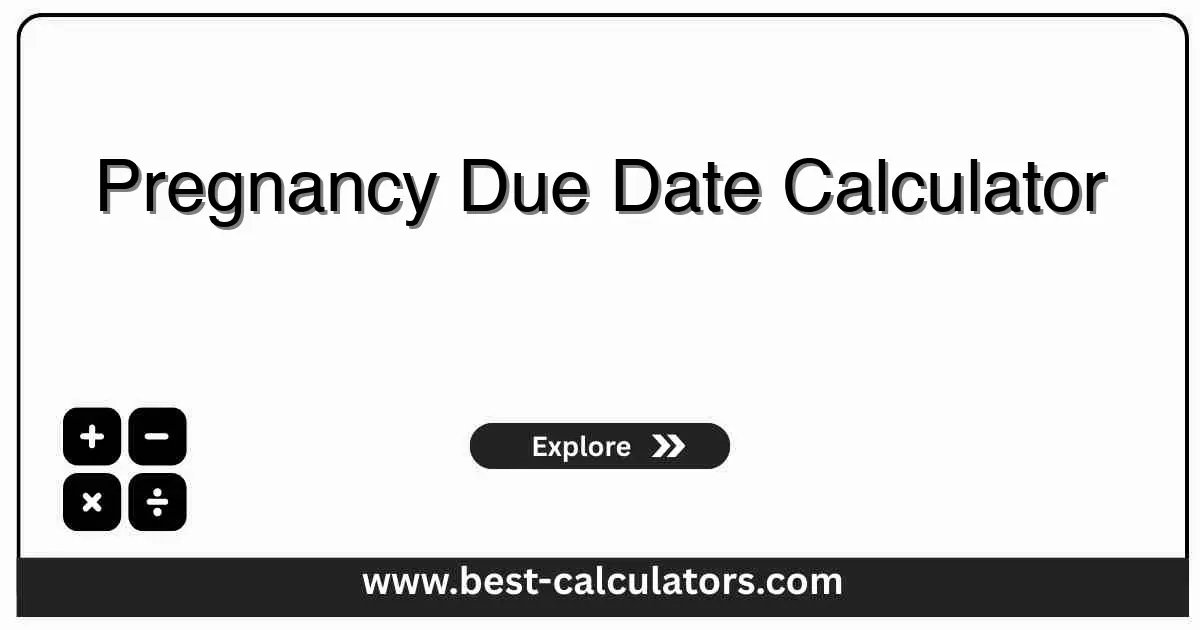Pregnancy Calculator - Calculate Your Due Date & Gestational Age
Calculate your pregnancy due date, current week, and trimester using your last menstrual period or conception date with accurate Naegele's rule calculations
Pregnancy Calculator
Your Pregnancy Results
What is a Pregnancy Calculator?
A Pregnancy Calculator is a medical tool that estimates your due date, current gestational age, and trimester based on either your last menstrual period (LMP) or conception date. It uses Naegele's rule, the standard obstetric formula that adds 280 days to your LMP to predict your baby's arrival date.
This calculator helps you:
- Estimate your baby's due date accurately
- Track your current week of pregnancy
- Identify which trimester you're in
- Plan prenatal appointments and milestones
- Calculate conception date if using LMP
For tracking recommended weight gain during pregnancy based on your BMI, use our Pregnancy Weight Gain Calculator to ensure healthy weight management throughout all three trimesters.
To calculate when conception likely occurred based on your due date, try our Pregnancy Conception Calculator for reverse dating calculations and fertility planning.
For calculating your pre-pregnancy BMI to assess healthy weight ranges, use our BMI Calculator to determine your starting weight category before pregnancy.
To calculate calorie needs during pregnancy for proper nutrition, try our Calorie Calculator to adjust your daily intake for pregnancy requirements.
How Pregnancy Calculator Works
The calculator uses Naegele's rule to estimate your due date:
Gestational age calculation:
- First trimester: Weeks 1-13 (embryonic development)
- Second trimester: Weeks 14-27 (rapid growth period)
- Third trimester: Weeks 28-40 (final development)
The calculator adjusts for cycle length variations. A standard 28-day cycle assumes ovulation on day 14. Longer or shorter cycles shift the conception date accordingly, affecting the due date calculation by the difference from 28 days.
Pregnancy Trimester Milestones
First Trimester (Weeks 1-13)
Major organ formation, neural tube development, heartbeat begins around week 6. Morning sickness and fatigue are common symptoms during this critical developmental period.
Second Trimester (Weeks 14-27)
Baby's movements felt (quickening), gender determination possible, rapid growth. Many women experience increased energy and the characteristic "baby bump" becomes visible.
Third Trimester (Weeks 28-40)
Lung maturation, weight gain, positioning for birth. Braxton Hicks contractions may occur as the body prepares for labor and delivery.
Full-Term Pregnancy
Week 37-42 is considered full-term. Most babies born between 39-41 weeks. Only 5% arrive on the exact due date calculated by the pregnancy calculator.
How to Use This Pregnancy Calculator
Choose Calculation Method
Select LMP or conception date based on what you know
Enter Date Information
Input the first day of your LMP or conception date
Adjust Cycle Length
Optionally specify your average menstrual cycle length
View Pregnancy Timeline
See your due date, current week, and trimester instantly
Benefits of Pregnancy Calculator
- • Accurate Due Date Estimation: Know when to expect your baby using scientifically validated Naegele's rule calculations.
- • Prenatal Planning: Schedule important appointments, tests, and milestones at appropriate gestational weeks.
- • Trimester Tracking: Understand which developmental phase you're in and what to expect next.
- • Birth Preparation: Plan maternity leave, hospital bags, and nursery setup with accurate timeline.
- • Medical Communication: Provide accurate gestational age information to healthcare providers.
- • Conception Date Calculation: Determine approximate conception date for family planning records.
Factors Affecting Due Date Accuracy
1. Irregular Cycles
Women with irregular menstrual cycles may ovulate earlier or later than day 14, affecting due date accuracy. Early ultrasound dating provides more precision in these cases.
2. Cycle Length Variation
Cycles shorter than 28 days mean earlier ovulation; longer cycles mean later ovulation. Adjusting for cycle length improves due date estimation significantly.
3. Ultrasound Dating
First-trimester ultrasound measurements are more accurate than LMP-based calculations, especially before 13 weeks when fetal growth is most consistent.
4. Assisted Conception
IVF and fertility treatments provide exact conception dates, making due date calculations more accurate than natural conception estimates.
5. Genetic Factors
Family history of early or late deliveries may influence actual delivery timing. First pregnancies tend to last slightly longer than subsequent ones.

Frequently Asked Questions (FAQ)
Q: How is my due date calculated?
A: Your due date is calculated using Naegele's rule: add 280 days (40 weeks) to the first day of your last menstrual period (LMP). This assumes a 28-day menstrual cycle with ovulation occurring on day 14.
Q: What is Naegele's rule for pregnancy dating?
A: Naegele's rule is a standard method to calculate the due date by adding 280 days to the first day of the last menstrual period, or adding 266 days to the conception date. This gives an estimated delivery date 40 weeks from LMP.
Q: How accurate is the pregnancy due date calculator?
A: The pregnancy calculator provides an estimate based on standard formulas. Only about 5% of babies are born on their exact due date. Most babies arrive within two weeks before or after the estimated due date, which is considered normal.
Q: What are the three trimesters of pregnancy?
A: Pregnancy is divided into three trimesters: First trimester (weeks 1-13), Second trimester (weeks 14-27), and Third trimester (weeks 28-40). Each trimester has distinct developmental milestones and maternal changes.
Q: Can I calculate my due date from conception date?
A: Yes, if you know your conception date, add 266 days (38 weeks) to calculate your due date. Conception typically occurs about 14 days after the first day of your last period in a regular 28-day cycle.